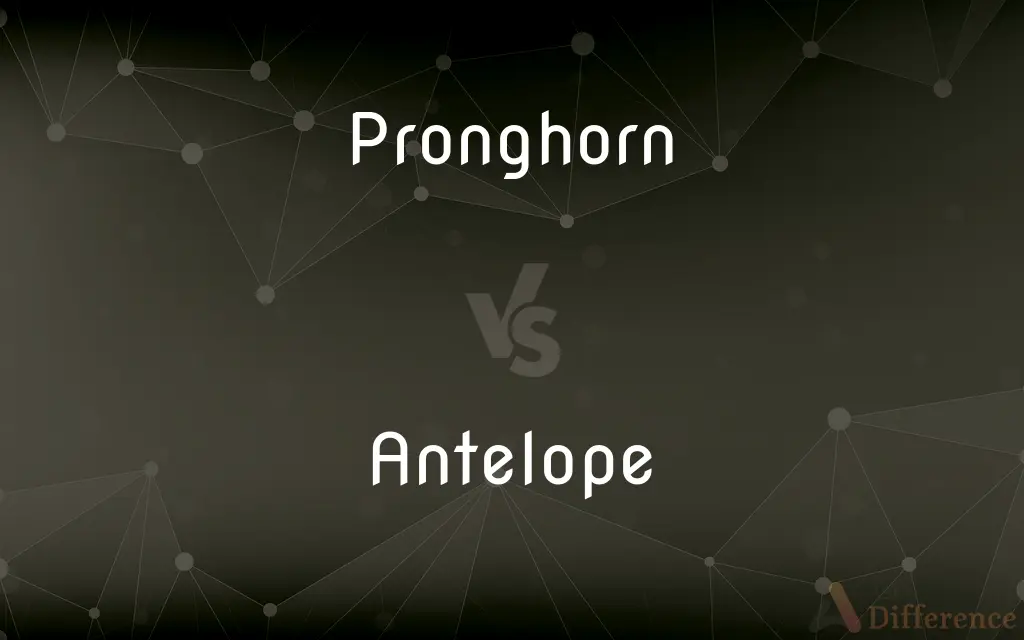Pronghorn vs. Antelope — What's the Difference?
By Tayyaba Rehman & Fiza Rafique — Updated on September 9, 2023
Pronghorn is a specific mammal native to North America, known for its speed and unique horns. Antelope refers to various species of ungulates mainly found in Africa and Asia, characterized by their slender bodies and long legs.

Difference Between Pronghorn and Antelope
Table of Contents
ADVERTISEMENT
Key Differences
Pronghorn is a unique animal native to the interior western and central areas of North America. Antelopes, on the other hand, are a group of species found mainly in Africa and some parts of Asia.
Pronghorn is notable for its incredible speed, second only to the cheetah. Antelopes also vary widely in their speed capabilities but are generally considered swift animals.
The horn structure of the Pronghorn is unique; they are the only animal with branched horns that they shed annually. Antelopes possess a wide variety of horn structures, which are generally unbranched and permanent.
Pronghorn belongs to its own family, Antilocapridae, and is not a true antelope. Antelopes belong to the family Bovidae and are more closely related to goats and cattle than to Pronghorn.
Comparison Chart
Location
North America
Mainly Africa, some in Asia
ADVERTISEMENT
Speed
Second only to cheetahs
Varies, generally swift
Horns
Branched, shed annually
Generally unbranched, permanent
Family
Antilocapridae
Bovidae
Variety
One species
Multiple species
Compare with Definitions
Pronghorn
Pronghorn is a fast-running ungulate native to North America.
The Pronghorn is often mistaken for an antelope but is a distinct species.
Antelope
Antelope refers to various species of hoofed mammals mainly found in Africa.
The African savannah is home to several species of antelope.
Pronghorn
Pronghorn is the second-fastest land animal.
The Pronghorn can run almost as fast as a cheetah.
Antelope
Antelopes are known for their slender bodies and long legs.
The antelope gracefully leapt over the obstacle.
Pronghorn
Pronghorn belongs to the Antilocapridae family.
Pronghorn is the sole surviving member of the Antilocapridae family.
Antelope
Antelopes often have permanent, unbranched horns.
The Springbok is an antelope with distinctive horns.
Pronghorn
Pronghorn is known for its unique branched horns.
The Pronghorn's branched horns set it apart from other ungulates.
Antelope
Antelopes belong to the Bovidae family.
Antelopes are related to goats and cattle.
Pronghorn
Pronghorn usually inhabits grasslands and deserts.
The Pronghorn prefers open spaces like the American West's grasslands.
Antelope
Leather made from antelope hide.
Pronghorn
The pronghorn (UK: , US: ) (Antilocapra americana) is a species of artiodactyl (even-toed, hoofed) mammal indigenous to interior western and central North America. Though not a true antelope, it is known colloquially in North America as the American antelope, prong buck, pronghorn antelope, prairie antelope, or simply antelope because it closely resembles the antelopes of the Old World and fills a similar ecological niche due to parallel evolution.
Antelope
Antelopes vary greatly in size and speed.
The size of antelopes can range from the small dik-dik to the large eland.
Pronghorn
A deerlike North American mammal with a stocky body, long slim legs, and black horns that are shed and regrown annually.
Antelope
The term antelope is used to refer to many species of even-toed ruminant that are indigenous to various regions in Africa and Eurasia. Antelope comprise a wastebasket taxon (miscellaneous group) within the family Bovidae, encompassing all Old World ruminants that are not bovines, sheep, goats, deer, or giraffes.
Pronghorn
A ruminant mammal (Antilocapra americana) of western North American plains that resembles an antelope, has forked horns that are shed and regrown annually, and is noted for its speed. Also called pronghorn antelope.
Antelope
A swift-running deerlike ruminant with smooth hair and upward-pointing horns, of a group native to Africa and Asia that includes the gazelles, impala, gnus, and elands.
Pronghorn
A North American mammal, Antilocapra americana, that resembles an antelope.
Antelope
Any of various swift-running ruminant mammals of the family Bovidae, native to Africa and Eurasia and having unbranched horns.
Pronghorn
An American antelope (Antilocapra Americana), native of the plain near the Rocky Mountains. The upper parts are mostly yellowish brown; the under parts, the sides of the head and throat, and the buttocks, are white. The horny sheath of the horns is shed annually. Called also cabrée, cabut, prongbuck, and pronghorned antelope.
Antelope
A pronghorn.
Pronghorn
Fleet antelope-like ruminant of western North American plains with small branched horns
Antelope
Any of several African mammals of the family Bovidae distinguished by hollow horns, which, unlike deer, they do not shed.
Antelope
(US) The pronghorn, Antilocapra americana.
Antelope
A fierce legendary creature said to live on the banks of the Euphrates, having long serrated horns and being hard to catch.
Antelope
One of a group of ruminant quadrupeds, intermediate between the deer and the goat. The horns are usually annulated, or ringed. There are many species in Africa and Asia.
The antelope and wolf both fierce and fell.
Antelope
Graceful Old World ruminant with long legs and horns directed upward and backward; includes gazelles; springboks; impalas; addax; gerenuks; blackbucks; dik-diks
Common Curiosities
What are the horns of an Antelope like?
Usually unbranched and permanent.
What is unique about Pronghorn horns?
They have branched horns that they shed annually.
Are Pronghorns a type of Antelope?
No, they are not a true antelope.
What is the native habitat of the Pronghorn?
Native to North America, mainly the western and central regions.
To which family does Pronghorn belong?
Belongs to the Antilocapridae family.
Where are Antelopes primarily found?
Primarily in Africa, with some species in Asia.
How fast are Antelopes?
Speed varies, but they are generally swift.
How fast can a Pronghorn run?
Second only to the cheetah in speed.
How many species of Antelopes are there?
Multiple species exist.
To which family do Antelopes belong?
Belong to the Bovidae family.
What do Pronghorns eat?
Mainly graze on grasses and shrubs.
What do Antelopes eat?
Diet varies but generally consists of grasses and leaves.
Are any Antelope species endangered?
Some species are at risk of extinction.
Is the Pronghorn endangered?
Generally not, but some subpopulations are at risk.
How large is a Pronghorn?
Typically around 4-5 feet in length and 3 feet in height.
Share Your Discovery

Previous Comparison
Goyish vs. Goyishe
Next Comparison
Intraspecific vs. IntraspeciesAuthor Spotlight
Written by
Tayyaba RehmanTayyaba Rehman is a distinguished writer, currently serving as a primary contributor to askdifference.com. As a researcher in semantics and etymology, Tayyaba's passion for the complexity of languages and their distinctions has found a perfect home on the platform. Tayyaba delves into the intricacies of language, distinguishing between commonly confused words and phrases, thereby providing clarity for readers worldwide.
Co-written by
Fiza RafiqueFiza Rafique is a skilled content writer at AskDifference.com, where she meticulously refines and enhances written pieces. Drawing from her vast editorial expertise, Fiza ensures clarity, accuracy, and precision in every article. Passionate about language, she continually seeks to elevate the quality of content for readers worldwide.















































